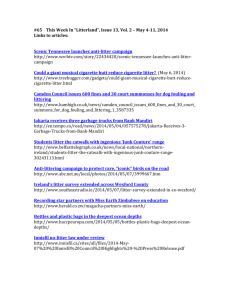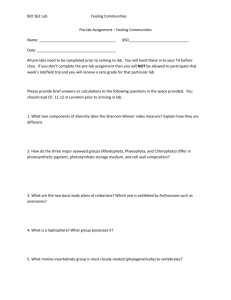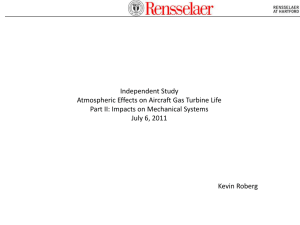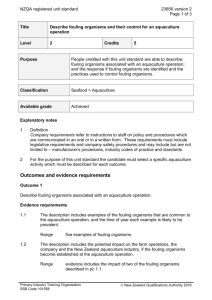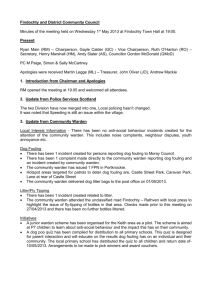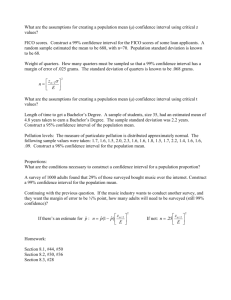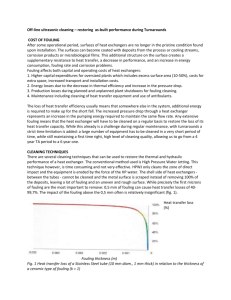Mitigation of Asphaltene Fouling with the Oil
advertisement
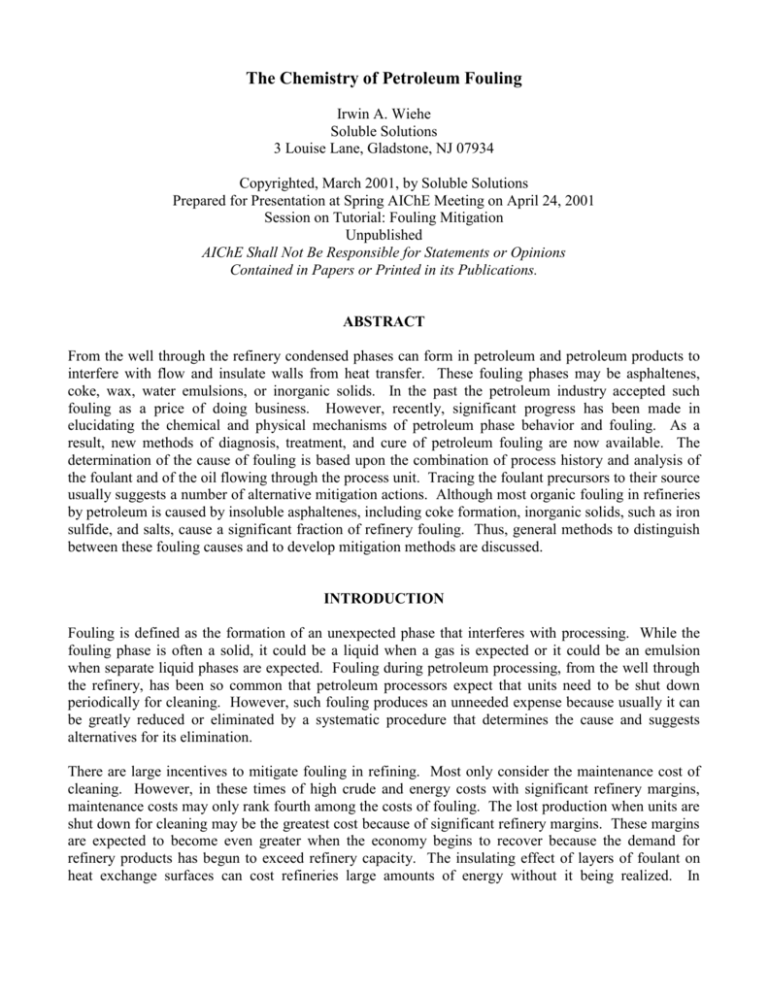
The Chemistry of Petroleum Fouling Irwin A. Wiehe Soluble Solutions 3 Louise Lane, Gladstone, NJ 07934 Copyrighted, March 2001, by Soluble Solutions Prepared for Presentation at Spring AIChE Meeting on April 24, 2001 Session on Tutorial: Fouling Mitigation Unpublished AIChE Shall Not Be Responsible for Statements or Opinions Contained in Papers or Printed in its Publications. ABSTRACT From the well through the refinery condensed phases can form in petroleum and petroleum products to interfere with flow and insulate walls from heat transfer. These fouling phases may be asphaltenes, coke, wax, water emulsions, or inorganic solids. In the past the petroleum industry accepted such fouling as a price of doing business. However, recently, significant progress has been made in elucidating the chemical and physical mechanisms of petroleum phase behavior and fouling. As a result, new methods of diagnosis, treatment, and cure of petroleum fouling are now available. The determination of the cause of fouling is based upon the combination of process history and analysis of the foulant and of the oil flowing through the process unit. Tracing the foulant precursors to their source usually suggests a number of alternative mitigation actions. Although most organic fouling in refineries by petroleum is caused by insoluble asphaltenes, including coke formation, inorganic solids, such as iron sulfide, and salts, cause a significant fraction of refinery fouling. Thus, general methods to distinguish between these fouling causes and to develop mitigation methods are discussed. INTRODUCTION Fouling is defined as the formation of an unexpected phase that interferes with processing. While the fouling phase is often a solid, it could be a liquid when a gas is expected or it could be an emulsion when separate liquid phases are expected. Fouling during petroleum processing, from the well through the refinery, has been so common that petroleum processors expect that units need to be shut down periodically for cleaning. However, such fouling produces an unneeded expense because usually it can be greatly reduced or eliminated by a systematic procedure that determines the cause and suggests alternatives for its elimination. There are large incentives to mitigate fouling in refining. Most only consider the maintenance cost of cleaning. However, in these times of high crude and energy costs with significant refinery margins, maintenance costs may only rank fourth among the costs of fouling. The lost production when units are shut down for cleaning may be the greatest cost because of significant refinery margins. These margins are expected to become even greater when the economy begins to recover because the demand for refinery products has begun to exceed refinery capacity. The insulating effect of layers of foulant on heat exchange surfaces can cost refineries large amounts of energy without it being realized. In addition, foulants reduce the efficiency of fractionators and reduce the reactivity in catalytic reactors. Finally, lower cost, opportunity crudes are often not purchased because of the fear of fouling or they are purchased and greater fouling results. In either case, fouling mitigation would reduce the cost of crude oil. Therefore, each refinery should carefully estimate these costs in determining their incentives for fouling mitigation. Most will conclude that they need not wait for a large fouling incident to justify a significant program on fouling mitigation. FOULING MITIGATION STRATEGY The best strategy to mitigate fouling is to elucidate the foulant chemistry and to use this basic knowledge to determine how and where to eliminate its formation. While there are methods to reduce the rate of fouling without knowing the cause, many of these merely pass the fouling problem on to the next unit. However, by stopping the foulant precursors from forming, the unexpected foulant phase can be eliminated from the refinery completely. Therefore, the four basic steps of our fouling mitigation strategy are: 1. Diagnosis: Determine the cause of fouling. 2. Investigation: Trace the cause to the source. 3. Innovation: Device ways to interrupt/reduce foulant precursors at each step. 4. Mitigation: Select the best of these ways for the particular refinery to implement. MOST COMMON CAUSES While the general fouling mitigation strategy will solve any refinery fouling problem, it makes sense to keep in mind the most common causes. Since 90% of refinery fouling is caused by only six basic causes, most fouling causes can be quickly identified by using tests or indicators for the diagnosis and investigation steps. Although some of these tests and indicators are proprietary, examples will be discussed among those that are not proprietary. The most common causes of refinery fouling are: 1. 2. 3. 4. 5. 6. Inorganics Oil Incompatibility on Mixing Coke from over thermal treating crude/resid/oil Oil-water emulsions Polymerization of olefins after thermal conversion Insoluble asphaltenes on cooling after conversion DIAGNOSIS The diagnosis is arrived from three sources of evidence: 1. Process conditions/history 2. Analysis of Foulant 3. Analysis of oil flowing through fouling unit Process Conditions/History The process conditions/history should include the range and average conditions (temperature, pressure, flow rate, and feeds) and should include upstream units as well as the fouling unit. What is most revealing is determining the difference in conditions when the unit was not fouling and when the unit was fouling. Can the initiation of fouling be correlated with a particular incident, such as a process upset, a contaminant (slop or sludge) addition, or a new feed? Analysis of the Foulant The analysis of the foulant usually reveals the most information about the cause. As a result, the foulant sample should be taken with care while recording information as to its location, amount, and exposure to cleaning liquids prior to sampling. Pictures of the foulant in the unit prior to sampling are very revealing. If the foulant is a solid, it should be ground and mixed to homogenize to obtain an average sample. The sample should be washed with a solvent, like methylene chloride or toluene, to remove the oil and then dried. If the foulant is soluble in the solvent, like an asphaltene sediment, a different sample should be washed with heptane. The first foulant analysis should be to determine how much is inorganic. An ash test, thermal gravimetric analysis (TGA), or elemental analysis may be used. If it is determined to be over 10 wt% inorganic, this cause should be determined, traced to the source, and mitigation action implemented before acting on the organic portion of the foulant. Often the inorganic foulant adsorbs organics out of the oil and elimination of the inorganic deposit also eliminates the organic portion of the foulant. Common inorganic foulants are iron sulfide, rust, sea salts, catalyst fines, clays or dirt, and ammonium chloride. Iron sulfide and rust are corrosion products. Therefore, they should be traced to the corrosion source or determined if they arrived in the crude oil. Iron sulfide is a black, granulated, insoluble solid that is often misidentified as coke. Iron sulfide can form directly from hydrogen sulfide reacting with iron or steel surfaces. Alternatively, iron naphthenate can form as an oil soluble salt by naphthenic acids in the oil reacting with steel surfaces and then reacting with hydrogen sulfide, that is released when oil is thermally cracked. If sea salts, sodium, calcium, and magnesium chlorides, are not removed in the desalter, they can deposit wherever the water is evaporated in the preheat train. Since calcium and magnesium chloride are not thermally stable, they can decompose in resid conversion units, hydroconversion or coking, to form hydrogen chloride and react with ammonia released by the conversion to form the solid, ammonium chloride. This salt can be washed out of the unit, such as a coker fractionator, with water or caustic can be injected after the desalter to convert calcium and magnesium chloride to sodium chloride. However, the preferred solution is to correct the desalter operation to more effectively remove the sea salts from the crude oil. Oil incompatibility1,2 is discussed in a separate paper3. However, coke forms from the thermal cracking of oil when asphaltenes become insoluble at thermal cracking temperatures4. The mechanism is as is shown in Figure 1. Asphaltenes in the oil contain thermally stable, polynuclear aromatic cores with pendant groups connected to the core by thermally unstable bonds. When exposed to high temperatures (above 350ºC), these bonds break to form free radicals. As long as the asphaltenes are dispersed in the rest of the oil, they abstract hydrogen from hydroaromatics and terminate the free radicals. However, the loss of pendant groups make the asphaltenes less soluble. Eventually, the converted asphaltenes become insoluble and undergo a liquid-liquid phase separation. This asphaltene rich phase has little or no abstractable hydrogen. As a result, the asphaltene free radicals combine to form high molecular weight and insoluble coke. However, before coke is formed, the polynuclear aromatics in the converted asphaltenes tend to orient with the large flat aromatics parallel to each other. This orientation can be detected by observing the coke with an optical microscope under crossed polarized light where ordered structures show up as bright while unordered (amorphous) structures are dark. Figure 2 shows coke formed from thermally cracking Cold Lake vacuum resid and dispersed in quinoline, an excellent solvent. The particles under normal light are spheres or agglomerate of spheres because of surface tension when it was a second liquid phase. Part of it is bright under cross polarized light because of the aromatic orientation. This is a liquid crystalline coke or the carbonaceous mesophase. Therefore, we use the presence of the carbonaceous mesophase in a foulant as an indicator to show that the foulant is coke that was formed by the asphaltene phase separation mechanism during thermal cracking. If the coke was formed by oil incompatibility on mixing and the insoluble asphaltenes were later thermally cracked, no carbonaceous mesophase would be observed. We5 have used the presence of carbonaceous mesophase in the heavy product of resid hydroconversion to detect that coke was forming in the reactor so that process conditions could be modified to eliminate further coke formation and avoided shutting the reactor down due to coke plugging. In addition, we have determined other indicators to detect the other common causes that enable quick diagnosis based upon foulant analysis. One of the simplest6 is to determine the hydrogen to carbon atomic ratio of the foulant (divide the wt.% hydrogen by wt.% carbon and multiply by 11.91): H/C Atomic 1.4 – 1.9 1.0 – 1.2 0.7 – 1.0 0.3 – 0.7 Foulant Wax Unconverted Asphaltenes Thermally Converted Asphaltenes Coke (Carbonaceous Mesophase) Figure 1. Mechanism of how coke forms from thermally cracking resid or oil. Figure 2. Micrograph showing spherical mesophase coke with bright areas under cross polarized light. Analysis of the Oil The analysis of the oil flowing through the fouled unit should be based upon what was learned from the foulant analysis. If the foulant analysis indicated the cause of the foulant, the precursors should be sought in the oil to confirm the diagnosis. For example if the foulant is over 10 wt.% iron sulfide, the incoming oil should be analyzed for soluble and insoluble iron and for naphthenic acids7 (Total Acid Number) and for reactive sulfur8. This should determine if the corrosion was in the unit or upstream of the unit and the type of corrosion if in the unit. On the other hand, if the foulant analysis is not able to distinguish among several causes, the oil should be analyzed for the complete range of possible precursors. Examples are shown below: Common Cause 1. Inorganics 2. Oil incompatibility on mixing 3. Coke 4. Oil-water emulsion 5. Polymerization of olefins 6. Insoluble asphaltenes Precursor Analysis Metals found in foulant (IC Plasma Emission Spect.) Oil Compatibility Tests Conradson carbon, asphaltenes, carbonaceous mesophase Presence of emulsion, surface active contaminants Dienes Asphaltenes with H/C atomic < 1.0, Oil Compat. Tests INVESTIGATION At this point the cause has been determined from the analysis of the foulant, identification of the precursor in the oil, and matching with process conditions and history. Now use the same analyses for the precursors in the oil to trace them in upstream units to the source. Where is the corrosion happening? Is the precursor coming into the refinery in one particular crude oil? Is the temperature too high in an upstream unit? Are the precursors coming from the recycle of slop or sludge? Basically, determine each step in the progression from incoming crude oil through upstream units until the foulant is deposited in the fouled unit and write this down along with evidence for each step. INNOVATION Now one needs a range of ideas of how to stop or interrupt each step in the progression from precursor in the crude oil to deposited foulant. Sometimes the possible ways are obvious. Do not process one particular crude oil; lower the temperature of one process unit; do not recycle one kind of slop; or mix oils in different proportions or order. However, often most of the possible ways seem to have negative implications or large costs. These could be direct costs, such as for additives or for testing each oil flowing in a particular unit. On the other hand, it might require capital costs, such as using more expensive alloys or some other modification of a unit. For these it is a good idea to meet with a group with diverse technical backgrounds and including those responsible for the affected upstream and downstream units. Then the group should brainstorm, flush out, and record all possible ways to stop or interrupt each step along with advantages and disadvantages of doing each. MITIGATION The mitigation phase focuses in on what is the best mitigation action for the refinery. The same group doing the innovation phase or a different group needs to evaluate each possible mitigation action that comes from the innovation and put them in priority order. This group should establish a quantitative measure of success to evaluate and to test the preferred mitigation action and make a recommendation to refinery management. Usually, the highest priority mitigation action is tested and if it meets the criteria of success, no others are tried. Of course, if the criteria are not satisfied, the next highest priority mitigation action is then tested. CONCLUSION A systematic procedure has been given for determining the cause of refinery fouling, tracing the precursors of fouling to the source, devising ways to stop the precursor formation, and selecting among alternatives for mitigation action. These are based upon understanding the chemical and physical mechanisms of the six most common causes of refinery fouling and the use of key indicators that enable the quick diagnosis of the fouling and focusing on the correct precursors. REFERENCES 1. I. A. Wiehe and R. J. Kennedy, “The Oil Compatibility Model and Crude Oil Incompatibility”, Energy & Fuels, 14, 56-59 (2000). 2. I. A. Wiehe and R. J. Kennedy, “Application of the Oil Compatibility Model to Refinery Streams”, Energy & Fuels, 14, 56-59 (2000). 3. I. A. Wiehe, “Mitigation of Asphaltene Fouling with the Oil Compatibility Model”, Proc. 4th International Conference on Refinery Processing, AIChE, NY (2001). 4. I. A. Wiehe, “A Phase-Separation Kinetic Model for Coke Formation”, Ind. Eng. Chem. Res., 32, 2447-2454 (1993). 5. I. A. Wiehe, “Mechanisms of Coke and Sediment Resulting from Resid Conversion”, Spring ACS Meeting, San Francisco (1997). 6. G. Brons and T. M. Rudy, “Logical Approach to Troubleshooting Crude Preheat Exchanger Fouling”, Proc. 2nd International Conference on Petroleum Phase Behavior and Fouling, Copenhagen (2000). 7. W. K. Robbins, “Challenges in the Characterization of Naphthenic Acids in Petroleum”, PREPRINTS, ACS Div. Petroleum Chem., 43, 137-140 (1998). 8. W. K. Robbins, “Challenges in the Analytical Characterization of Non-Thiophenic and Thiophenic Sulfur Compounds in Petroleum”, PREPRINTS, ACS Div. Petroleum Chem., 45, 68-71 (2000).
